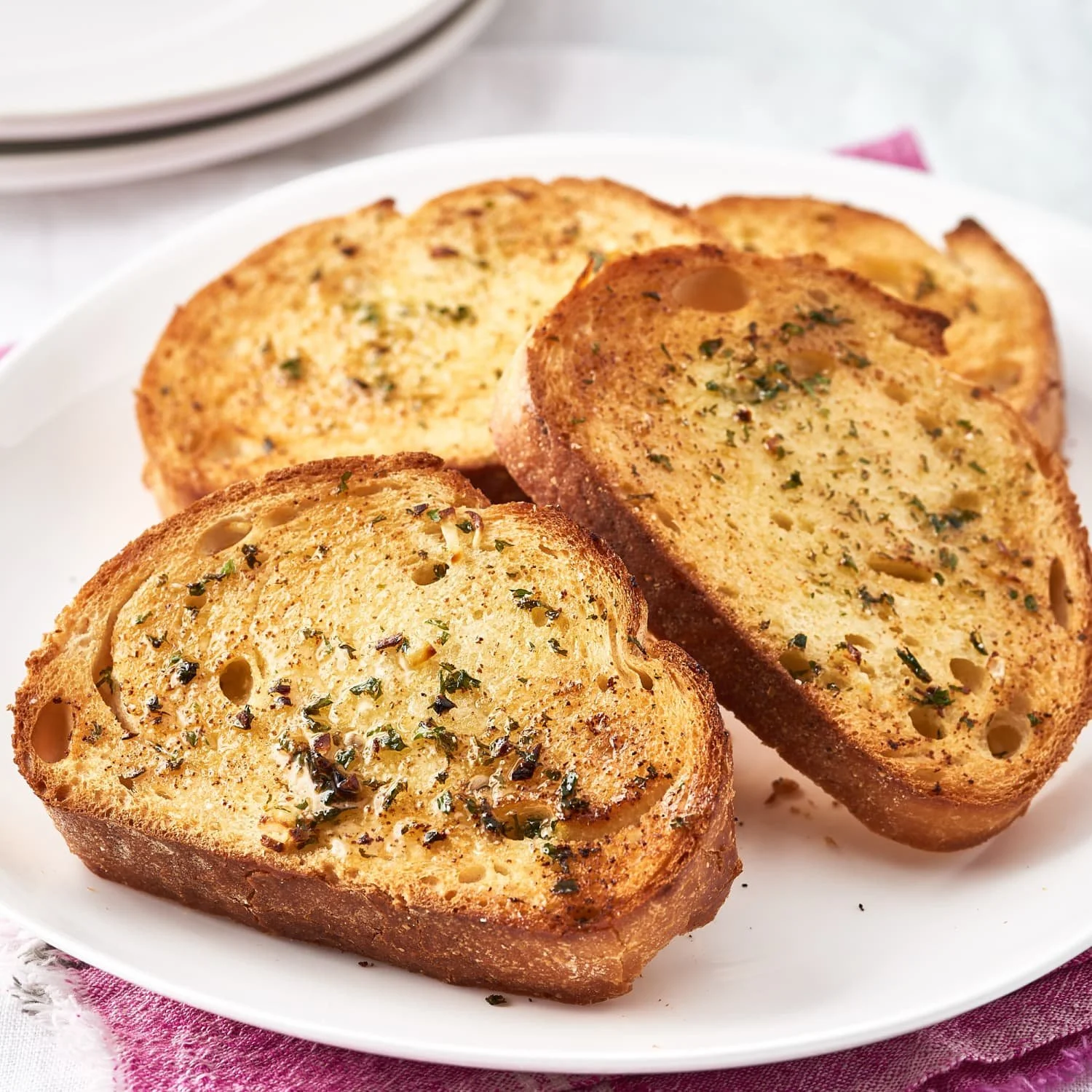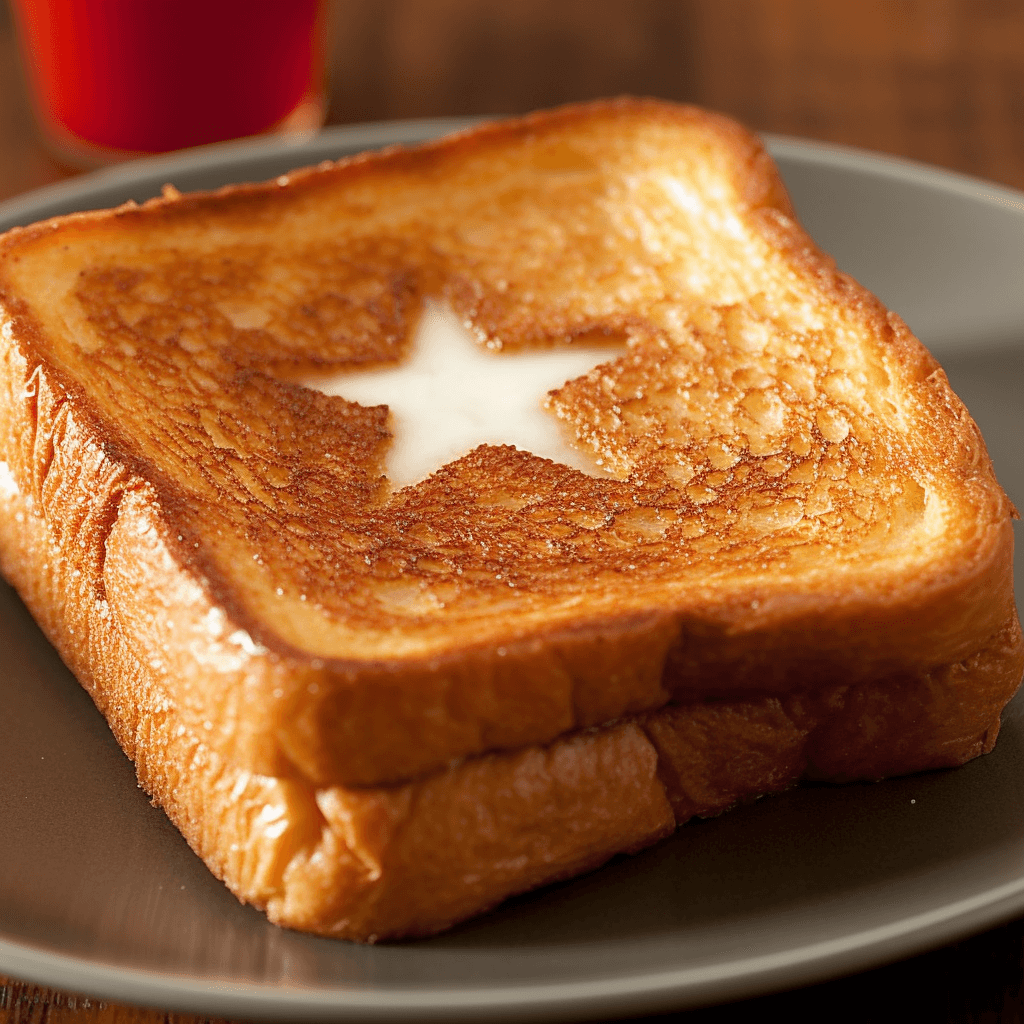Texas Toast
Crisp, Golden, and Flavourful Delight Explained
Texas Toast, a culinary delight from the South, is a thick-sliced white bread (What wine goes well with bread?) known for its buttery crust and soft interior. A comfort food staple, this toast is characterized by slices that are often double the usual thickness of ordinary bread slices. It's a versatile bread option that can be found as a side dish for various meals, perfectly complementing hearty dishes like soups and pasta (how long does pasta last?) or acting as accompaniment for savory mains like ribs.
The key to the unmistakable taste of Texas Toast lies in the butter mixture that is generously applied to both sides of the bread. The classic preparation involves a concoction of melted butter, often infused with fresh garlic and sometimes accompanied by fresh parsley, which is brushed onto the bread with a pastry brush. The addition of garlic butter elevates a simple piece of bread to a homemade garlic bread that exudes a captivating aroma and offers a rich flavor profile.
Cooking Texas Toast is a simple process, but the technique is paramount: the bread slices are grilled or broiled to achieve a golden brown perfection. The toast is typically cooked over medium heat for about 2-3 minutes each side, or in an oven for a controlled approach. Some opt for variations by adding cheese atop the buttery slices before heating, resulting in a layer of bubbly golden cheese. Whether served as a side or enjoyed on its own, every serving of Texas Toast contributes both texture and flavor, transforming any ordinary meal into a more satisfying dining experience.
History of Texas Toast
Texas toast has roots in the American South and has become widely recognized for its thick slices and versatility as a side dish. This section explores the history of this iconic bread and how it has spread in popularity.
Origins
Texas toast is believed to have been created in the 1940s at Kirby's Pig Stand in Beaumont, Texas. According to accounts, thicker bread slices were provided by a local bakery, which did not fit in standard toasters. Instead of thinning the bread, Pig Stand's cooks innovatively grilled the bread slices with butter, creating a toast of unusual thickness. This practice set the foundation for what would become known as Texas toast.
Popularity and Spread
Initially a novel approach to accommodate thicker than usual bread slices, Texas toast quickly grew in popularity. The simple preparation, involving generous smears of butter and grilling to golden brown perfection, made it a comfort food staple. The thick slices pair well with a variety of dishes, serving as an excellent side to soups, pasta, and particularly as bread for ribs. Its satisfaction and ease of preparation contributed to Texas toast becoming a sought-after product in both restaurants and households across the United States.
Ingredients and Variations
Texas Toast, known for its thick-cut slices and buttery garlic flavor, can be enjoyed in its classic form or customized through a variety of regional and dietary adaptations.
Classic Ingredients
Ingredients for traditional Texas Toast include thick slices of white bread, often doubled in thickness compared to ordinary bread slices for a heartier serving of food. This bread loaf is typically slathered with a butter mixture that combines melted butter, fresh garlic or garlic powder, (how long does garlic powder last?) and optionally, fresh parsley or Italian seasoning for enhanced flavor. The slices are then grilled or baked to a golden brown.
Prep Time: Ranges from a quick 2-3 minutes of assembly to a complete 4-6 minutes of cooking on medium heat or in an oven.
Slices of Bread: Thicker than sandwich bread, sometimes up to an inch
Butter Mixture:
Butter: Always use melted for even coating
Garlic: Fresh or powder for a robust taste
Herbs: Such as parsley for a garnish
Regional Variations
Across different areas, Texas Toast might be served with unique regional variations. In some places, cheese is added on top to create a meltier, more decadent side dish, perfect alongside comfort foods like soups and pasta. In the South, you might find recipes that use potato bread or bread boule for a slight flavor variation.
Cheeses: Cheddar, mozzarella for a gooey twist
Breads: Potato, submarine style for diversity
Spices: Region-specific like Cajun or barbecue seasoning (how long does barbecue seasoning last?)
Dietary Adaptations
For those with specific dietary needs or preferences, there are several adaptations to the classic Texas Toast recipe. Gluten-free bread can replace white bread for celiac or gluten-sensitive individuals. A vegan version might use plant-based butter and skip the cheese.
Gluten-Free: Substituting with gluten-free bread slices
Vegan: Using dairy-free butter and omitting cheese
Low-Sodium: Reducing or eliminating added salt
Preparation Techniques
Texas Toast is known for its thick slices and rich, buttery flavor, often seasoned with garlic. Whether crafted using traditional methods or with modern cooking conveniences, the preparation of Texas Toast is focused on achieving a golden brown exterior and a soft interior.
Traditional Method
The traditional approach to making Texas Toast begins with selecting the right type of white bread—usually a loaf that is dense enough to hold its structure when saturated with butter. Potato bread or a bread boule can be used for their sturdy texture. The bread is sliced to a usual thickness that far exceeds that of ordinary sandwich bread, ideally ranging between 3/4" and 1" thick.
A mixture of melted butter, often mixed with fresh garlic, salt, and sometimes fresh parsley, is created. Each slice of bread is generously brushed on both sides with this garlic butter using a pastry brush. The bread is then toasted on a griddle or in a skillet over medium heat for about 2-3 minutes per side or until each side is golden brown and crispy.
Ingredients for a traditional Texas Toast include:
Bread loaf: Choose a thick, dense loaf suitable for slicing.
Butter mixture: Combine melted butter with garlic powder or fresh garlic, salt, and herbs.
Other seasonings: Fresh parsley to add a mild, herby flavor.
Technique:
Preheat griddle or skillet to medium heat.
Cut the bread into thick slices using a bread knife.
Brush both sides of each bread slice with the prepared butter mixture.
Toast each side for 2-3 minutes or until golden brown.
Modern Cooking Methods
Modern cooking methods leverage the convenience of kitchen appliances like an oven, which can accommodate multiple slices of bread at once. For oven toasting, the oven is typically preheated to around 375 degrees Fahrenheit. Bread slices are arranged on a baking sheet after being slathered with the butter mixture, which may include traditional ingredients like garlic powder, melted butter, and salt.
For an even more indulgent twist, some recipes suggest adding cheese or crunchy bread crumbs (how long do bread crumbs last?) on top before baking. The toast is baked for 4-6 minutes or until the desired crispness is reached. Some prefer the ease of commercially available Texas Toast, which is often found frozen with garlic butter already added, requiring only heating through in an oven for a quick and convenient serving of food.
Instructions for oven-baked Texas Toast:
Preheat the oven to 375 degrees Fahrenheit.
Slice the bread into the desired thickness.
Mix melted butter with garlic powder, salt, and optional cheese.
Generously apply the mixture onto the bread slices with a pastry brush.
Place bread onto a baking sheet and bake for 4-6 minutes or until golden brown and crisp.
These modern techniques not only provide a great accompaniment to hearty dishes like soups, pasta, and ribs but also add a quick and easy side option for everyday meals.
Recipe Variations
Texas Toast can be more than just a grilled piece of bread. The versatility of this thick-cut bread makes it ripe for variation, leading to an array of mouthwatering dishes that cater to various tastes and meal courses.
When preparing French toast, bread slices are typically soaked in a mixture of eggs and milk. However, by opting for Texas Toast's usual thickness, each slice holds up better, offering a custardy bread interior with a golden brown exterior. The use of potato bread or a bread boule instead of ordinary bread slices transforms the French toast into a more decadent serving of food.
For homemade garlic bread, the infusion of melted butter, fresh garlic, and fresh parsley creates an aromatic and flavor-packed spread. This butter mixture is usually applied with a pastry brush to ensure even coating. Medium heat grants control over achieving the perfect golden brown texture without burning. Beyond using conventional white bread, alternative breads such as submarine bread or even a bread loaf cut with a bread knife to desired thickness can be utilized.
In table format, here's a simple guide for different ways to toast bread:
Classic:
White bread, butter, garlic powder, salt
Prep Time: 5 min
Cook Time: 4-6 min
Cheesy Garlic Toast:
Bread of choice, garlic butter, cheese, salt
Prep Time: 7 min
Cook Time: 4-6 min
French Toast:
Texas Toast, eggs, milk, sugar, cinnamon
Prep Time: 10 min
Cook Time: 2-3 minutes per side
Whether it's a hearty breakfast or the perfect accompaniment to soups and pasta dishes, Texas Toast takes on new life. A crusty exterior sprinkled with crunchy bread crumbs or laden with melted cheese turns a slice of Texas Toast into the ideal comfort food. Contrastingly, for those favoring oven-baked over grilled, think of a toast recipe where a thick-cut piece of bread becomes a warm, cheesy explosion after a few minutes in the oven.
To summarize, Texas Toast's recipe variations are extensive, allowing for its easy incorporation into dishes beyond a side of bread for ribs or a sandwich bread. Whether it's adopting new flavors, changing prep methods, or altering the bread's usual thickness, Texas Toast proves its adaptability and stands out as a beloved bread product.





